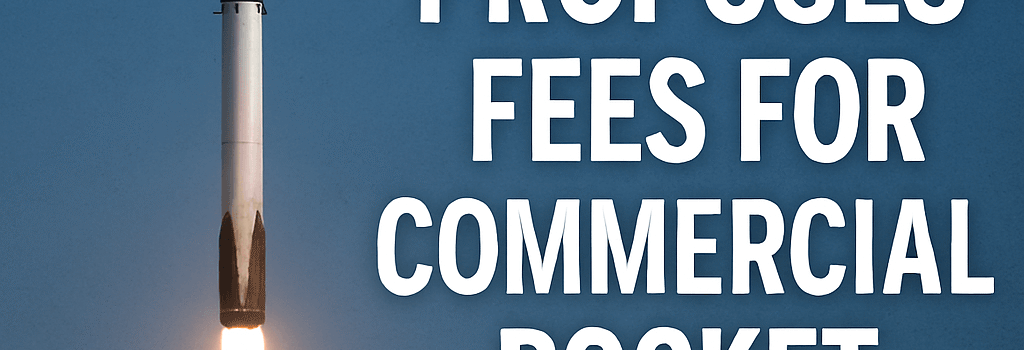FAA Proposes Fees for Commercial Rocket Payloads

The Federal Aviation Administration (FAA) is poised to introduce a new fee structure for commercial space operators, charging per pound of payload mass to integrate rockets safely into the National Airspace System (NAS). The move follows sustained lobbying for dedicated funding as launch cadence and complexity surge.
Background: Budget Reconciliation Bill & FAA’s AST
In June 2025, Sen. Ted Cruz (R-Texas), chairman of the Senate Commerce Committee, released text from the fiscal year 2026 budget reconciliation bill that would empower the FAA’s Office of Commercial Space Transportation (AST) to assess licensing fees beginning in calendar year 2026. The eight-year phase-in schedule is designed to build a sustainable trust fund for AST’s operating costs, addressing a gap that has widened as commercial activity ballooned.
Historically, AST’s annual budget rose from $16.6 million in 2015 to over $42 million in 2024, while the number of issued launch and reentry licenses jumped from 11 to 164 over the same period. However, flat funding in 2025–26 fails to match projected growth, with over 200 commercial missions expected this year alone—predominantly by SpaceX’s Falcon 9 fleet.
The Proposed Fee Structure
- 2026: $0.25 per pound of payload, capped at $30,000 per launch or reentry
- 2033: $1.50 per pound, capped at $200,000 per launch or reentry
- Post-2033: Rates adjusted annually to reflect the Consumer Price Index (CPI)
Under these tiers, a typical 37,500 lb Starlink mission would incur:
- ~$9,375 in fees in 2026
- ~$56,250 in fees in 2033 (before reaching the cap)
SpaceX’s 89 dedicated Starlink launches in 2024 would have generated roughly $834,000 under the initial rate, scaling to multi-million-dollar contributions as fees ramp up.
Technical Integration and Safety Systems
To manage an increasingly crowded NAS—29 million square miles carrying 45,000 daily flights and 2.9 million passengers—the FAA has accelerated development of advanced traffic management tools:
- Space Data Integrator 2.0: A real-time telemetry platform, recently piloted at Wallops Flight Facility during Rocket Lab’s Neutron test, that feeds launch trajectories into the FAA’s automation core.
- System Wide Information Management (SWIM): Aggregates commercial flight plans, uses XML messaging to overlay launch windows and dynamic restricted airspace segments.
- Automated Conformance Monitoring: Employs ADS-B and radar feeds to ensure separation minima are honored between ascending rockets and transiting aircraft.
These systems dovetail with the FAA’s NextGen modernization initiatives, leveraging cloud-native microservices, machine-learning anomaly detection, and resilient satellite-based augmentation to enhance situational awareness.
International Regulatory Landscape
Globally, peers are exploring parallel regimes:
- EASA (Europe) is drafting a payload-based levy for launches from French Guiana, slated for 2027 implementation.
- JCAB (Japan) held consultations in early 2025 on a tiered licensing fee tied to launch vehicle diameter and orbital class.
- Civil Aviation Administration of China (CAAC) remains exempting state-backed commercial launches but has signaled future cost-recovery frameworks.
Economic Impact on Satellite Operators
Constellation operators face incremental costs. Amazon’s Project Kuiper will pay per-pound charges on its 3,000 kg geostationary ring launches, potentially adding $750,000 per mission by 2033 under current caps. Smaller rideshare customers—e.g., CubeSat deployers—would see lower absolute fees but a higher fee fraction relative to their manifest value.
Expert Opinions and Industry Reaction
“As commercial spaceflight expands rapidly, so does its impact on the National Airspace System. This proposal ensures operators help underwrite the infrastructure they rely on.”
—Sen. Ted Cruz (R-Texas)
“Passenger airlines pay significant taxes to modernize the NAS. We must ensure the airspace can accommodate an increased cadence in space launch.”
—Bryan Bedford, FAA nominee and Republic Airways CEO
The Commercial Spaceflight Federation, representing members like SpaceX and Blue Origin, argues that launching rockets less frequently than passenger jets does not yet justify similar fee burdens. Meanwhile, United Launch Alliance has indicated support for “fair, equitable fees that do not disadvantage U.S. firms in the global marketplace.”
Projected Revenue and Future Outlook
Based on industry growth curves—200 launches in 2025 scaling to 350 by 2030—the FAA could see annual trust fund inflows of $5 million–$15 million by the decade’s end. This revenue will fund additional AST staff, expand range instrumentation, and refine collision-avoidance algorithms.
Should SpaceX transition its Starlink program entirely to Starship (100 metric ton payload capacity) by 2033, individual fees would quickly hit the $200,000 cap. Even so, per-launch fees would remain under 1% of projected Starship operational costs, preserving room for robust industry expansion.
Conclusion
The proposed payload-based fee regime represents a pivotal step toward a self-sustaining FAA commercial space office. As launch frequency and complexity accelerate—with Artemis missions, hypersonic tests, and expanding satellite constellations—the ability to modernize the NAS will hinge on stable, predictable funding streams.